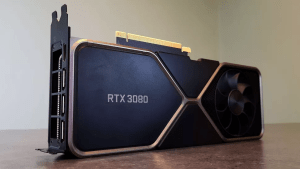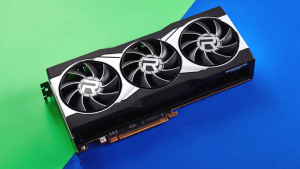
1. Nvidia GeForce RTX 3080
Okay, right now, the RTX 3080 is rare as pigeon eyelashes, but there is no doubt Nvidia’s new RTX 3080 is the best graphics card today. It represents a huge generational performance boost over the previous RTX 20-series. That’s impressive when put up against either the RTX 2080 or 2080 Super, but when you consider that this nominally $699 card can not just match but massively outperform the $1,200 RTX 2080 Ti, it really hits home.
The thing which really stands out from our testing is the difference it makes to ray-tracing performance. The first generation of ray tracing-capable cards required such a huge frame rate sacrifice that most people shied away from turning it on, but that’s no longer the case with this generation.
When you can now get ray-traced performance that exceeds the frame rates you’d get out of the top card of the RTX 20-series when running without it, you know that this is a whole different beast. And hey, the RTX 3080 can actually run Crysis.
Nvidia has managed this by adding a whole load more CUDA cores to the mix in this 8nm GPU and updated Tensor Cores (for extra DLSS goodness) and second-gen RT Cores to make with the ray-traced pretties.
The RTX 3080 may need a fair chunk more power—you’ll want at least an 850W PSU—and be tricky to get hold of, but this is the most desirable graphics card around today. Which I guess is also why it’s so tricky to get hold of.
If there was one bit of advice for buying a GeForce RTX 3080 it would be that it’s worth trying to get your hands on the Founders Edition if at all possible. Pick your expletive, because the RTX 3080 Founders Edition is ****ing great. Far from just being the reference version of the ‘flagship’ Ampere graphics card, because of that cooler and redesigned PCB, it is the ultimate expression of the RTX 3080. And if you end up with another version of this fine-ass GPU then I’m afraid you’re likely to feel a little hard done by.
Chances are you’re going to have to make do. The Founders Edition cards are not produced in the same volumes as the third-party versions from the likes of Asus, MSI, Gigabyte, Palit, and Colorful, to name but a few. Given the stock shortages, you’re going to be happy with whatever RTX 3080 you can get your hands on. Especially if you can get one near to the MSRP. And besides, some of the cooling options on these third-party cards are impressive in their own right, so it’s not all bad by any stretch.
Regardless of whichever card you get your hands on, the performance uplift you get over the previous generation is huge and pretty much unprecedented. Maybe we’ve become used to more iterative generational deltas, especially considering the slight difference between the GTX 1080 Ti and RTX 2080, for example. But we’re going to continue beating the Ti drum, because it bears repeating—the fact the $699 RTX 3080 absolutely smashes the $1,200 RTX 2080 Ti is still staggering.
Nvidia has gone big with the RTX 3080, and the result is an outstanding gaming card that sets a new benchmark for both high-end 4K gaming performance and for ray tracing. Now we just need Nvidia and Samsung to make more of them so we can all enjoy the best GPU of this generation.

2. AMD Radeon RX 6800 XT
As a red team alternative to Nvidia’s high-end graphics cards, there have been few finer than the RX 6800 XT. A highly competitive card that comes so close to its rival, with a nominal performance differential to the RTX 3080, is truly an enthusiast card worth consideration for any PC gamer with 4K in their sights.
The RX 6800 XT was the first of AMD’s RDNA 2 GPUs to enter the fray, and while we’ve had plenty of other cards since, this is the one that shines brighter than most and makes the most sense financially. At least it does if you consider its MSRP, and with AMD’s GPUs returning to reasonable price levels quicker than Nvidia’s, this could actually give the red team the edge in the short term.
A key battleground for Nvidia and AMD this generation has been on the memory front—covering both bandwidth and capacity. The RX 6800 XT comes with 16GB of GDDR6 across a 256-bit bus for a total bandwidth of 512GB/s. That means AMD has Nvidia’s 10GB RTX 3080 on the ropes in terms of capacity but falls slightly behind in raw bandwidth to the RTX 3080’s 760GB/s.
AMD has an ace up its sleeve in throughput terms in the form of its Infinity Cache, which bolsters the cards ‘effective bandwidth’ considerably. Some 1,664GB/s, by AMD’s making—a 3.25x improvement over the RX 6800 XT’s raw bandwidth. In gaming terms, it means you’re looking at similar performance, despite the very different underlying technologies.
It’s a tough call between the RX 6800 XT and the RTX 3080, but the latter pips AMD to the post with the final touches à la RTX. The RX 6800 XT is $50 cheaper, delivers high 4K performance, and a hefty VRAM increase over the RTX 3080. However, it’s easy to argue that an extra $50 dropped on the RTX 3080 is money well spent: a small price to pay for greater 4K performance, much-improved ray tracing, and DLSS. All are available today and with years of developer support in the bank.
That said, AMD’s FidelityFX Super Resolution has gained considerable momentum among developers and offers solid upscaling that’s worth enabling in supported games.
The RX 6800 XT leaves AMD in an incredibly strong position going forward, delivering what is required to get the entire industry to take notice, and with a strong proposition to offer gamers instantly at launch. And it’s no surprise to hear the cooperation between Zen and RDNA engineers had a part to play in all this, too.
All of which is to say that AMD has evolved on what was already a promising architecture in RDNA and delivered it in a fantastic graphics card in the RX 6800 XT. And not the least bit impressive in just how swiftly it has achieved near performance parity with Nvidia. There’s still some way to go to claw back market share from the green team, but step one on RTG’s to-do list (build a high-end GPU) can be confidently checked off with the release of the RX 6800 XT.
We’re big fans of what AMD has managed to accomplish with the RX 6800 XT, a return to form for the Radeon Technology Group that injects some much-needed competition into the GPU market and offers a worthy red team alternative for any high-end gaming PC build.
